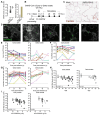Aging shapes infection profiles of influenza A virus and SARS-CoV-2 in human precision-cut lung slices
- PMID: 40128814
- PMCID: PMC11934781
- DOI: 10.1186/s12931-025-03190-0
Aging shapes infection profiles of influenza A virus and SARS-CoV-2 in human precision-cut lung slices
Abstract
Background: The coronavirus disease 2019 (COVID-19) outbreak revealed the susceptibility of elderly patients to respiratory virus infections, showing cell senescence or subclinical persistent inflammatory profiles and favoring the development of severe pneumonia.
Methods: In our study, we evaluated the potential influence of lung aging on the efficiency of replication of influenza A virus (IAV) and severe acute respiratory syndrome coronavirus 2 (SARS-CoV-2), as well as determining the pro-inflammatory and antiviral responses of the distal lung tissue.
Results: Using precision-cut lung slices (PCLS) from donors of different ages, we found that pandemic H1N1 and avian H5N1 IAV replicated in the lung parenchyma with high efficacy. In contrast to these IAV strains, SARS-CoV-2 Early isolate and Delta variant of concern (VOC) replicated less efficiently in PCLS. Interestingly, both viruses showed reduced replication in PCLS from older compared to younger donors, suggesting that aged lung tissue represents a suboptimal environment for viral replication. Regardless of the age-dependent viral loads, PCLS responded to H5N1 IAV infection by an induction of IL-6 and IP10/CXCL10, both at the mRNA and protein levels, and to H1N1 IAV infection by induction of IP10/CXCL10 mRNA. Finally, while SARS-CoV-2 and H1N1 IAV infection were not causing detectable cell death, H5N1 IAV infection led to more cytotoxicity and induced significant early interferon responses.
Conclusions: In summary, our findings suggest that aged lung tissue might not favor viral dissemination, pointing to a determinant role of dysregulated immune mechanisms in the development of severe disease.
Keywords: Aging; Distal lung; Influenza virus; Precision-cut lung slices; SARS-CoV-2.
© 2025. The Author(s).
Conflict of interest statement
Declarations. Ethical approval and consent to participate: All human tissues were gathered and managed in accordance with the Declaration of Helsinki, and the study was approved by the Swiss Ethics Committee, Bern, Switzerland, approval number KEK-BE_2018-01801. Written informed consent was obtained from all donors before recruitment. Consent for publication: Not applicable. Competing interests: The authors declare no competing interests.
Figures




Similar articles
-
Viral Determinants in H5N1 Influenza A Virus Enable Productive Infection of HeLa Cells.J Virol. 2020 Jan 31;94(4):e01410-19. doi: 10.1128/JVI.01410-19. Print 2020 Jan 31. J Virol. 2020. PMID: 31776276 Free PMC article.
-
H5N1 Influenza A Virus PB1-F2 Relieves HAX-1-Mediated Restriction of Avian Virus Polymerase PA in Human Lung Cells.J Virol. 2018 May 14;92(11):e00425-18. doi: 10.1128/JVI.00425-18. Print 2018 Jun 1. J Virol. 2018. PMID: 29563290 Free PMC article.
-
The novel human influenza A(H7N9) virus is naturally adapted to efficient growth in human lung tissue.mBio. 2013 Oct 8;4(5):e00601-13. doi: 10.1128/mBio.00601-13. mBio. 2013. PMID: 24105764 Free PMC article.
-
Heterogeneity in transmissibility and shedding SARS-CoV-2 via droplets and aerosols.Elife. 2021 Apr 16;10:e65774. doi: 10.7554/eLife.65774. Elife. 2021. PMID: 33861198 Free PMC article.
-
Innate Immunity and Influenza A Virus Pathogenesis: Lessons for COVID-19.Front Cell Infect Microbiol. 2020 Oct 22;10:563850. doi: 10.3389/fcimb.2020.563850. eCollection 2020. Front Cell Infect Microbiol. 2020. PMID: 33194802 Free PMC article. Review.
References
-
- Kochanek KD, Murphy SL, Xu J, Arias E. Deaths: Final Data for 2017. Natl Viral Stat Rep. 2019. 68(9). - PubMed
-
- Onder G, Rezza G, Brusaferro S. Case-fatality rate and characteristics of patients dying in relation to COVID-19 in Italy. JAMA. 2020;323(18):1775. - PubMed
-
- Jain S, Kamimoto L, Bramley AM, Schmitz AM, Benoit SR, Louie J, et al. Hospitalized patients with 2009 H1N1 influenza in the United States, April–June 2009. N Engl J Med. 2009;361(20):1935. - PubMed
MeSH terms
LinkOut - more resources
Full Text Sources
Medical
Miscellaneous

